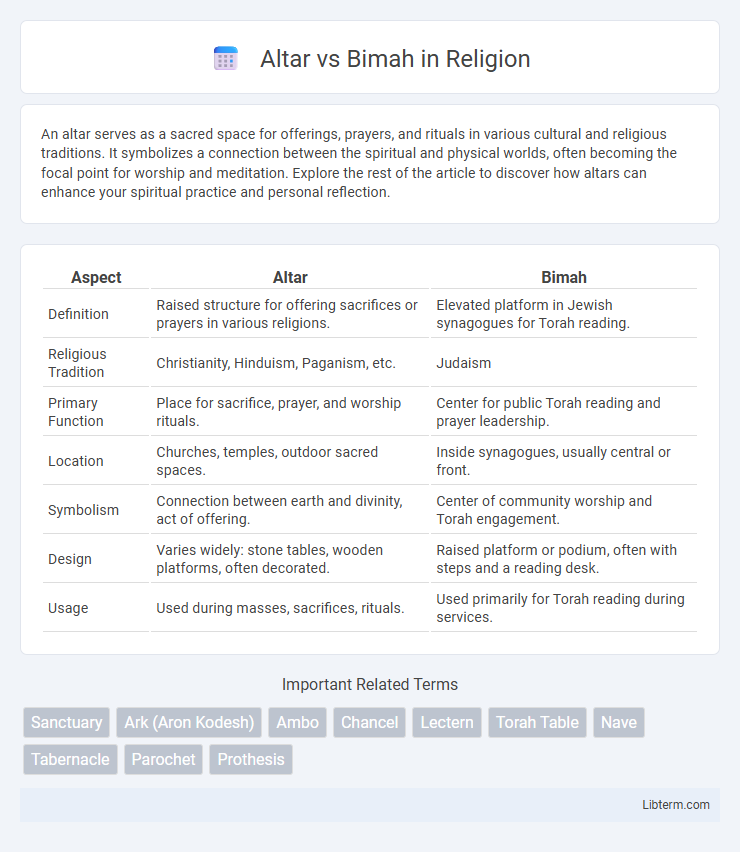An altar serves as a sacred space for offerings, prayers, and rituals in various cultural and religious traditions. It symbolizes a connection between the spiritual and physical worlds, often becoming the focal point for worship and meditation. Explore the rest of the article to discover how altars can enhance your spiritual practice and personal reflection.
Table of Comparison
| Aspect | Altar | Bimah |
|---|---|---|
| Definition | Raised structure for offering sacrifices or prayers in various religions. | Elevated platform in Jewish synagogues for Torah reading. |
| Religious Tradition | Christianity, Hinduism, Paganism, etc. | Judaism |
| Primary Function | Place for sacrifice, prayer, and worship rituals. | Center for public Torah reading and prayer leadership. |
| Location | Churches, temples, outdoor sacred spaces. | Inside synagogues, usually central or front. |
| Symbolism | Connection between earth and divinity, act of offering. | Center of community worship and Torah engagement. |
| Design | Varies widely: stone tables, wooden platforms, often decorated. | Raised platform or podium, often with steps and a reading desk. |
| Usage | Used during masses, sacrifices, rituals. | Used primarily for Torah reading during services. |
Understanding the Altar: Definition and Purpose
The altar, central in Christian worship, serves as the sacred space for Eucharistic rites and offerings, symbolizing sacrifice and divine presence. Typically positioned at the front of a church, the altar functions as a consecrated table where bread and wine are transformed during Communion. Unlike the bimah, which is a raised platform used in Jewish synagogues for Torah reading, the altar emphasizes sacrificial worship and liturgical ceremonies.
Exploring the Bimah: Meaning and Function
The Bimah, a raised platform in Jewish synagogues, serves as the focal point for Torah reading and prayer, symbolizing the central role of scripture in worship. Unlike the altar, which is primarily associated with sacrificial offerings in ancient temples, the Bimah emphasizes communal participation and accessibility to sacred texts. Its elevated position facilitates visibility and audibility, reinforcing the communal nature of Jewish liturgical practices.
Historical Origins of the Altar and Bimah
The altar and bimah trace their historical origins to distinct religious traditions, with the altar rooted in ancient Christian and pagan worship as a sacred platform for offerings and sacrifices. The bimah, originating in Jewish synagogues, served as a raised platform for reading the Torah and leading prayer, emphasizing communal engagement and auditory clarity. Both structures evolved to symbolize focal points of spiritual connection, reflecting their unique liturgical functions across millennia.
Religious Significance in Worship
The altar holds central religious significance in Christian worship as the sacred table where the Eucharist is consecrated, symbolizing Christ's sacrifice and presence. The bimah, essential in Jewish worship, is a raised platform from which the Torah is read, representing the community's engagement with the divine word and serving as a focal point for prayer and study. Both structures embody vital connections between worshippers and the sacred, facilitating ritual acts that express faith and devotion in their respective traditions.
Architectural Placement in Sacred Spaces
The altar is traditionally positioned at the eastern end of a Christian church, serving as the focal point for liturgical rituals and symbolizing the presence of Christ. In contrast, the bimah in a synagogue is centrally located within the sanctuary, emphasizing the communal reading and study of the Torah. This architectural placement reflects differing theological priorities: the altar's forward placement directs worship towards the divine altar, while the bimah's central location fosters congregational participation and accessibility.
Rituals and Practices Associated with the Altar
The altar serves as a sacred space in Christian rituals where the Eucharist is consecrated and offerings are presented during worship services. It is central to the liturgy, symbolizing Christ's sacrifice and facilitating the ritual of communion with consecrated bread and wine. In contrast, the bimah in Jewish practice functions as the platform from which the Torah is read, emphasizing scripture reading and prayer rather than sacrificial rituals.
Ceremonies and Roles of the Bimah
The Bimah, a central platform in synagogues, serves as the primary location for reading the Torah during Jewish ceremonies, emphasizing its pivotal role in worship and community participation. Unlike an altar, which is traditionally used in sacrificial rites, the Bimah facilitates the engagement of congregants by elevating the Torah reader, thereby enhancing visibility and audibility during religious services. This structure anchors key rituals such as the Torah service, bar and bat mitzvahs, and communal prayers, underscoring its importance in Jewish liturgical practice.
Key Differences Between Altar and Bimah
The altar, primarily found in Christian churches, serves as a sacred table used for Eucharistic rituals and offering sacrifices, symbolizing Christ's presence and sacrifice. The bimah, located in synagogues, is an elevated platform from which the Torah is read and prayers are led, emphasizing communal participation and study. Unlike the altar's focus on sacrificial rites, the bimah centers on Torah reading and worship leadership.
Cultural Variations and Interpretations
The altar, central in Christian worship, symbolizes sacrifice and communion with God, often crafted as an elevated table in churches. The bimah, prominent in Jewish synagogues, serves as the podium from which the Torah is read, emphasizing communal participation and learning. Cultural variations reflect these differing theological emphases, with altars focusing on sacrificial rituals and bimahs on scriptural engagement and public prayer.
Contemporary Relevance and Adaptations
The altar, central in Christian worship, has evolved to reflect modern liturgical practices with minimalist designs and versatile materials, enhancing community engagement and inclusivity. The bimah, pivotal in Jewish synagogues, has adapted through contemporary architecture and technology, facilitating inclusive participation and accessibility during Torah readings. Both structures embody evolving spiritual expressions, balancing tradition with the demands of contemporary worship environments.
Altar Infographic

 libterm.com
libterm.com